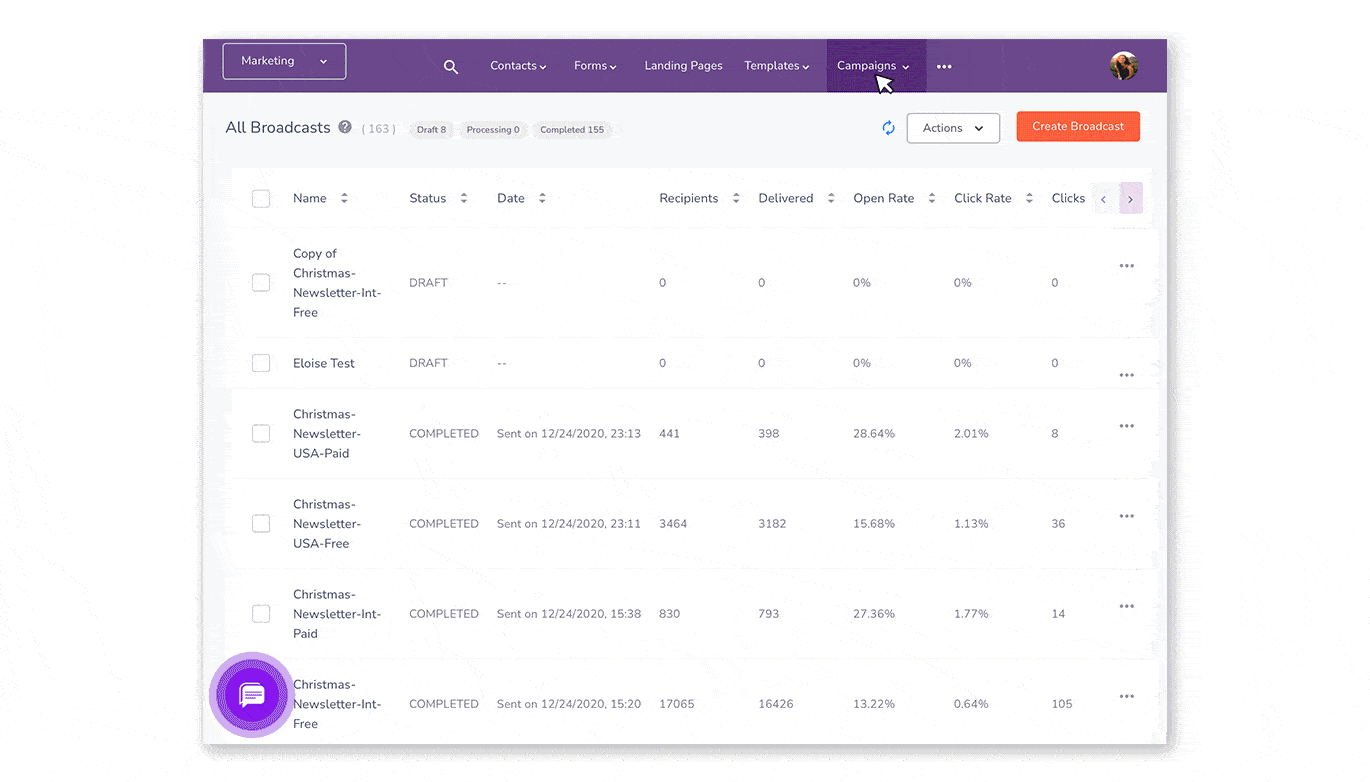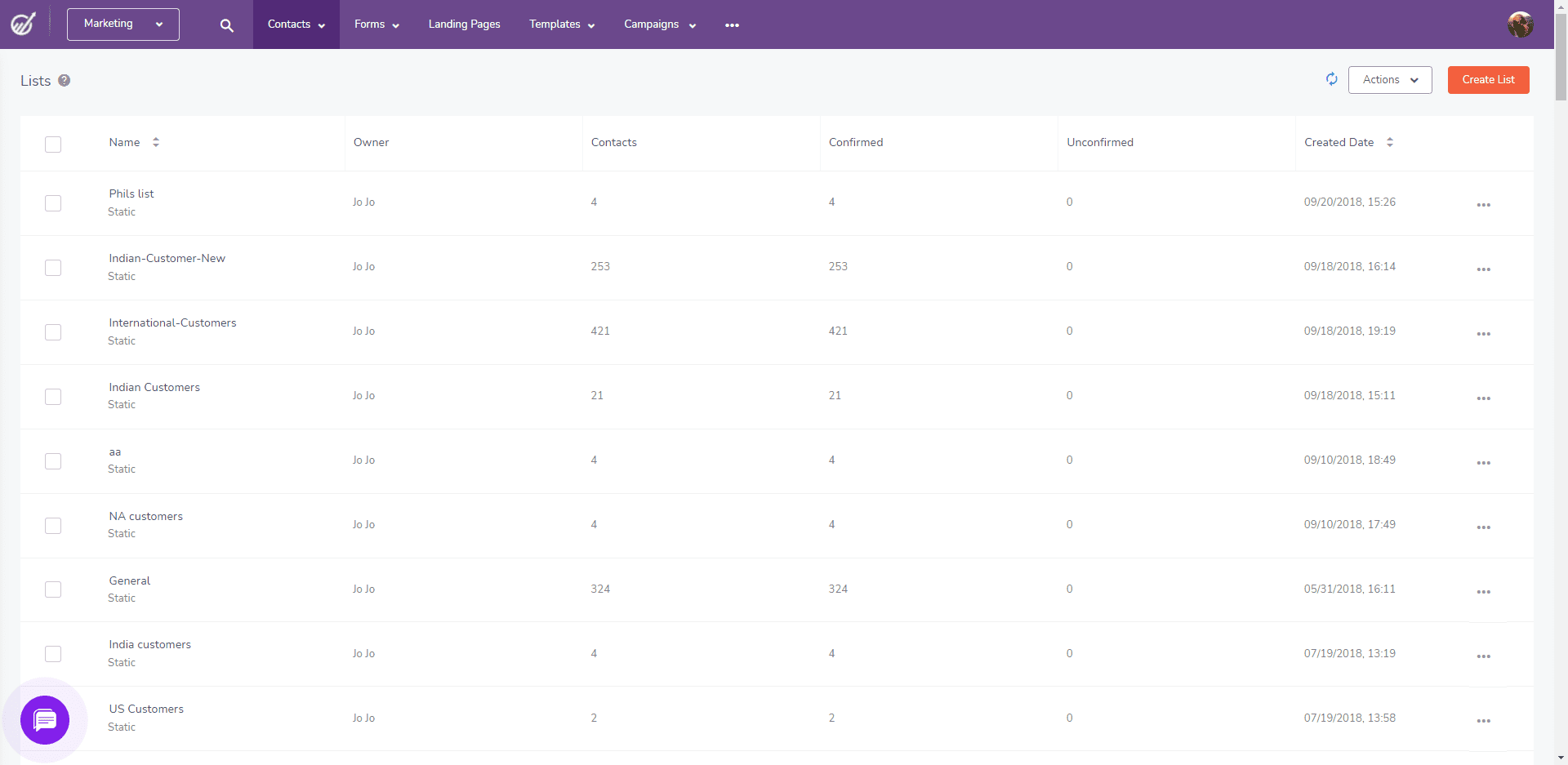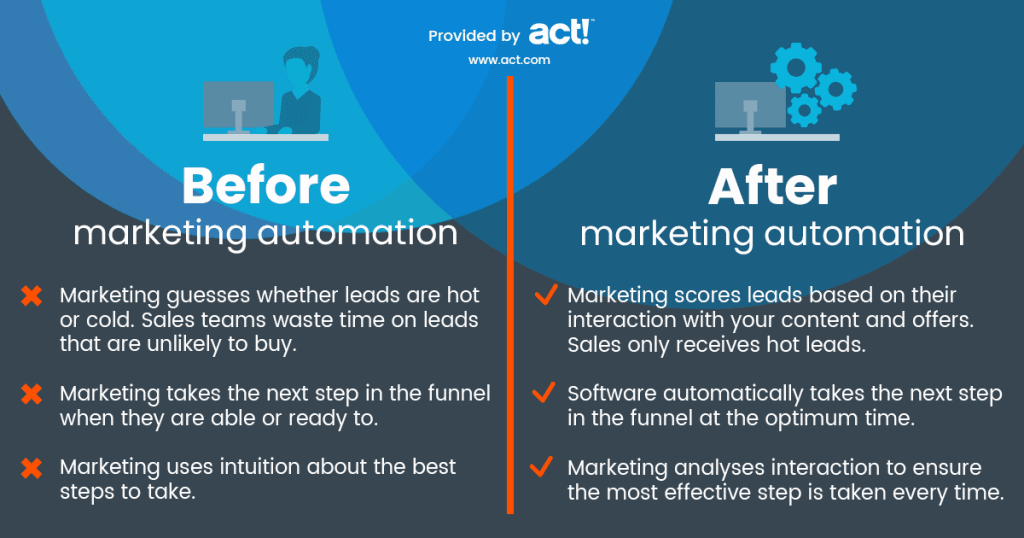Marketing automation can be key to ramping up your company’s efficiency as it allows you to devote more time to your most valuable asset—your customers.
By implementing an effective marketing automation tool, your company can better target your audience and potential clients across multiple platforms, such as social media, email automation, and text messages.
Karra Hendrix, product marketing manager at Act-On, explains:
“Marketing automation is all about understanding your audience so you can adapt the way you communicate to them based on their unique buying journey.”
So, what does this mean for your company, and why should you use a marketing automation platform?
Almost all marketers (98%) say that effective marketing automation is crucial to a company’s long-term success.
This blog post covers seven key steps that help you build your successful marketing automation strategy.
Let’s get started.
Table of Contents
What Is Marketing Automation?
Marketing automation refers to the use of software to automate various marketing activities.
You can choose to automate anything, right from the process of identifying prospects to nurturing your leads and converting them into customers.
Activities include drip email campaigns, social media posting, ad campaigns, and much more. Besides, these tools can be highly beneficial in providing a personalized experience.
What Is a Marketing Automation Strategy?
A marketing automation strategy refers to the playbook brands use to automate their marketing. A good marketing automation strategy improves the efficiency of your sales funnel, as it makes sharing of information easy — delivering exceptional customer support in the process.
However, an efficient marketing automation strategy streamlines everything across the complete vertical, so no more shooting in the dark. The plan also lets you know the ‘what, who, where, and when’ of your marketing action plan.
Who’s your target audience? What types of marketing campaigns should you choose? Where should you add your marketing content to? How will your marketing team execute the plan?
Read also: Marketing Automation 101 For The Beginner [With Examples]
Why Does Marketing Automation Matter?
Firstly, marketing automation can help increase efficiency, resulting in higher ROI.
Let us show you two reasons why:
77% of businesses reported an increase in their conversions. 30% of marketers identified saving time as the biggest benefit of marketing automation, followed by lead generation (22%), increase in revenue (17%), and customer retention (11%).
Clearly, you can’t undermine the role of marketing automation in your business growth.
Want more benefits? Here’s a brief list.
Read also: The Ultimate Guide To B2B Marketing Automation In The Digital Age
The Benefits of Using Marketing Automation
Recent research shows that 77% of chief marketing officers (CMOs) at top-performing companies use marketing automation for business and revenue growth.

Here are some of the ways marketing automation can benefit your business:
- Increase customer lifetime value (CLV) by automating cross-selling, up-selling, and customer follow-ups.
- Reduce staffing costs by setting up lead nurturing and marketing campaigns triggered by customer actions or behaviors.
- Allows you to refine marketing processes to target better and nurture your leads.
- Allows for better marketing and sales accountability by clearly defined processes and metrics for measuring campaign effectiveness and activities.
- Allows you to amplify the effect of your marketing initiatives.
- Replace manual and repetitive marketing tasks to free up time for creative tasks.
- Reach potential customers in a personalized way across multiple channels.
Read also: Marketing Automation Best Practices for the Non-Technical Marketer
Which Tasks Can Be Automated?
Effective marketing automation platforms are designed to scale alongside your company without automating all your marketing efforts. But you need to approach marketing automation with caution.
“By over-automating your marketing, you manage an entire customer journey instead of optimizing it,” says Chris Davis, director of education at ActiveCampaign.
Marketing automation is best used to build a database of qualified leads and determine which type of communication will be most effective for your lead.
Over time and via various points of contact, you will have sufficient customer data to place your buyers and potential clients in groups determined by common customer behaviors, demographics, and interests.

Another way to use this strategy for pursuing leads is by implementing sales alerts.
Implementing sales alerts is another excellent option for pursuing leads.
According to Salesforce, marketing automation can track visitors and generate real-time sales alerts. These alerts will automatically follow up with your company’s leads at a time determined by your sales department.
This can then be delivered automatically to buyers across websites, text messages, and email marketing automation technology. Studies show that over one billion dollars are wasted annually due to inefficient marketing.
In fact, 67% of marketers say their departments are inefficient.
This is primarily due to one or more of the following:
- Lack of tracking performance
- Employees working in silos
- Not using marketing automation
- Placing quantity (of content marketing assets) before quality
- Not placing the right focus on particular social media platforms
To avoid such inefficiencies, companies need to align their marketing automation goals with the buyer’s journey.
Read also: Marketing Automation Use Cases & Examples From Top Brands
Steps to Align Your Marketing Automation Strategy with the Buyer’s Journey
Let’s look at what can be done best and how.
- Understand buyer personas
- Map out the buyer’s journey for each persona
- Conduct a content audit
- Understand your analytics
- Talk to sales and support
- Map out programs and activities that will get you in front of buyers at each stage
- Map out the systems and technologies needed to support the initiatives outlined
1. Understand buyer personas
This step is crucial to align your marketing automation objectives with the buyer’s journey. You need to know who your ideal customer is so you can deliver relevant content.
Also, be familiar with your buyers’ demographics and where they search for information.
To create and understand your buyers’ personas, consider conducting interviews and surveys from sales, marketing, customer service, and finally, the customers themselves.

This step will help you establish content that aligns with your customer’s goals.
A few examples:
- Facebook and Twitter analytics can offer insights into the topics and trends most relevant to your business.
- Google Analytics can provide information on who visits your website — and what terms are being searched.
- You can also talk to your sales teams about the types of customers and leads they interact with. Find out what the most frequently asked questions are.
- Interviewing customers and prospective buyers will improve insights, and so will researching issues facing your industry.
This, in turn, will help your business target the right audience on Facebook and other social media sites.

2. Map out the buyer’s journey for each persona
You know your potential customer will transition through the phases of awareness, consideration, decision, and purchase phases of the buyer’s journey.
To make your marketing efforts pay off, you must align your marketing automation goals with each phase of the customer’s journey.
After all, 95% of B2B buyers conduct more than half of their research online before reaching out to a company. So matching content with their interests and behavior is critical.
You should also clearly understand the buyer’s way of thinking and how they will contact your company and move forward.
The best way to approach this is to make the next step easy for potential buyers in their journey with your business.
To appeal to the many types of buyers, you should create multiple pathways and opportunities for them to engage in and progress along the journey.
Send emails, inbound marketing newsletters, and personalized text messages with your marketing automation software.
Questions to consider while mapping out the journey:
- What are the challenges for the buyer, and what do buyers think at each stage of the journey?
- What type of information do buyers need at each stage?
- What type of questions do buyers ask at each stage?
- What content would support them at each stage?
- What terms might a prospect search for at each stage?
To put this into action, you need to:
- Discover the questions buyers are asking
- Identify members of the buying team
- Choose the right medium and format
- Be visible where the buyer is
- Optimize your personalized content with keywords and relevant terms
Read also: 6 Steps to Create Your CRM Strategy (+How to Track It)
3. Conduct a content audit
How do you know if your content is strategic and effective during the buyer’s journey?
Although you can track and measure performance, you can also conduct a content audit to optimize the customer’s experience.
This is a great way to know what content works with your buyers.
A content audit will tell you which content is effective, what you should keep, and what can be changed to improve the buyer’s journey and appeal to your target audience.
This will save time and money—so neither is wasted on ineffective marketing.
Check out the video below for an overview:
Check out this post on how to conduct a content audit using SEMrush.
4. Understand your analytics
Understanding your analytics is key to mapping your company’s game plan and marketing strategy.
For example, let’s say you know how much time it takes for a potential buyer to progress to an opportunity and how much time it takes for the opportunity to close.
You need to know where potential buyers get stuck or fail to progress in the buying journey so that you can create a successful marketing automation plan for your company’s success.
That said, there’s no use if you can’t interpret the charts and graphs and figure out how they affect the bigger picture.

For example, consider the following:
- Awareness stage: you can track the number of visitors to your site and the sources from which they arrive.
- Consideration stage: you can monitor click-through rates and cost per lead.
- Decision stage: you can track the cost per acquisition.
While the above metrics are quite simple, they form the basis for exploring your analytics at a deeper level and diagnosing any issues.
Read also: A B2C Marketing Automation Guide To Reach Buyers With Less Effort
5. Talk to sales and support
Dan Galante, a business writer and sales and marketing professional, says:
“Sales teams can provide a lot of information about customers, product concerns or issues and objections they face. They are frontline soldiers that have a direct line to customer intelligence.”
Insights into each stage of the buyer’s journey can only help with efficiencies and lead to better outcomes with your marketing automation.
How do you create better alignment with the buyer’s journey?
- Spend time with your top sales personnel to get insights into how, when, and who you reach out to — and refine your buyer profiles.
- Find out your sales team’s successes and roadblocks.
- Encourage dialogue between sales and marketing teams and ensure no overlap exists with sales communications.
Read also: The Ultimate Guide To Marketing Automation For Small Businesses
6. Map out programs and activities that will get you in front of buyers at each stage
To ensure that your marketing automation is put to good use, plan activities and programs that will put you in front of your buyers throughout the buyer’s journey.
One way to do this is by tracking your customer’s engagement and identifying which content or means of marketing automation works for the buyer.
For example, one customer might respond to your email marketing efforts and another to social media outlets.
Try to understand what potential buyers are looking for and maintain a relationship with them even after the purchase.
Read also: Understanding Customer Journeys in Marketing Automation: A Guide
7. Map out the systems and technologies needed to support the initiatives outlined
If your goal is to create predictable revenue growth, the secret to success lies in creating scalable processes.
This is particularly critical when deciding on the marketing automation systems and technologies to support your initiatives.
Investing in marketing automation technologies can be one of the most difficult and important decisions a business makes.
Lack of content and an effective strategy will undermine any digital marketing or lead-generation effort.
However, ensuring the right marketing automation tool can have a multiplier effect on the results.
Questions to ask when selecting marketing automation tools:
- What are your business needs at your current size?
- What are your marketing automation tools capable of?
- How easy and intuitive are they to use?
- To what level can you customize it to do what you want it to do?
- Can you use it to personalize content and the customer experience?
- How well does it align with your buyer’s journey and with sales?
- Can it be scaled—is it flexible enough for your future needs?
- Will it integrate with your CRM?
- Can it track and measure the performance of several initiatives?
- What intelligence can it offer to make your marketing smarter?
- What’s the support like?
- Does it fit the budget?
Here’s are some good marketing automation software:
EngageBay: An all-in-one marketing, sales, and customer support software designed specifically for SMBs, startups, and solopreneurs. Offers features like contact management, email marketing, omnichannel marketing automation, drip campaigns, sales pipelines, appointment scheduling, helpdesk, and live chat.
HubSpot: An expensive but powerful all-in-one (called flywheel) marketing and CRM software with a clean UI. You get advanced features, including social media management, lead management, email campaigns, and more. While it’s a great option for larger companies with a significant marketing budget, the expensive plans make it unviable for SMBs.
Salesforce: Ranked #1 CRM in the world, Salesforce is a great enterprise-level marketing automation software, with plans for small and medium businesses (though these plans are still expensive and may have hidden charges and add-ons).
Picking the right marketing automation software is crucial for the success of your business. Choose wisely.
Read also: Maximizing Inbound Marketing Automation For Exponential Growth
Ensure your Marketing Automation Strategies Serve Your Customers
Whether it is a small business or a major brand, successful marketing automation is key not only to acquire new customers but also to nurture them throughout the sales journey.
Aligning your content and messaging with the buyer’s journey is essential for your marketing automation program’s success.
Understanding your buyer’s preferences and using effective communication are the key first steps to ensuring your marketing automation strategies align with the buyer’s journey.
They will help bridge any gaps between lead acquisition and sales development, increase closing rates, strengthen bottom lines, and create enduring relationships with your customers.

EngageBay is an excellent marketing automation platform for small businesses and startups alike. With multichannel marketing, audience segmentation, marketing activity timelines, 360-degree customer view, and more, you can easily automate your marketing processes.
Here’s one of EngageBay’s users, Lauraine M, with a sweet testimonial:
Other small business owners also love our product as it’s cost-effective, powerful, and easy to use. Hear from some of them:
Sign up for the free version now, or book a 30-minute demo with one of our experts.
👉🏽Boost your online store’s revenue with these 7 must-try eCommerce marketing automation strategies and tools!





